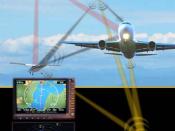The Capstone program was a joint effort between the Federal Aviation Administration and the Alaskan aviation community to improve aviation safety and efficiency by putting cost effective and new technology avionics equipment into the aircraft. In this term paper, I intend to briefly explain Capstone, the need for Capstone, and the future of Capstone.
There was a real need for Capstone in the nation but especially in Alaska. There was an average of 1 aircraft accident every other day in Alaska during the past 10 years. Furthermore, there was an average of 1 aviation fatality every 9 days in Alaska during the past 10 years. Alaska has approximately 10% of the nation's air carriers or commercial operators but it generates 35% of the accidents. In addition, of the commercial pilots that spend their career flying in Alaska, more than 11% will perish in their aircraft, as compared to 2.5% of the pilots in the other 49 states.
Since Alaska has these frightening facts the FAA in partnership with the Alaskan aviation community decided to begin the Capstone project in Southeast Alaska in Fiscal year 2001. As the National Transportation Chairman Jim Hall said, "Fatal air crashes in Alaska were three times higher than other states in '94."
The Alaskan based Capstone was a program designed to promote safety using contemporary technology like Global Positioning Satellites (GPS). First, Capstone unifies multiple programs under one ADS-B (Automatic Dependent Surveillance Broadcast) screen too improve safety for everyone sharing the skies. Moreover, in a Capstone equipped aircraft, the pilots gets information concerning his aircraft relation to terrain on an ADS-B screen and receives information about traffic around him. This is especially helpful in a holding pattern when conditions are less than VFR. Another major thing Capstone provides is a "real time" weather...


